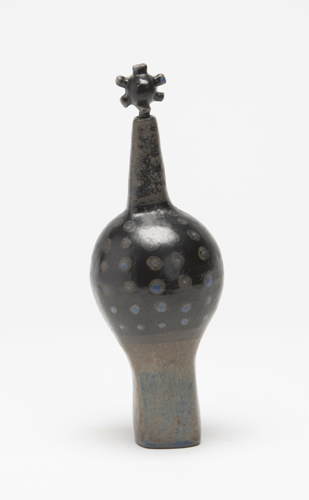Acquisition Number: 2023.6
Medium:
Ceramic
Size:
8 x 2 1/2 x 2 1/2 in.
Date:
n.d.
Credit: Gift of Warren McCullough
in memory of Marjorie McCullough
Leza McVey’s work led the way for modern ceramic art in the U.S. Said to be ahead of her time, McVey hand-built organic forms inspired by nature. Traditionally, professional standing in the ceramic community had been measured by proficiency in throwing on the wheel. It was daring to return to "primitive" hand-building, which had been acceptable only for those without adequate skill. But Leza said that hand-building was better for expressing the energies of growing things, and found the symmetry achieved on the potter's wheel to be boring.
Many of Leza's works, like this one, feature a bottle shape with a stopper at the end. The stoppers often took on an element of the surreal in their shapes that looked like abstracted animal heads—cats or chickens, or in this case maybe a lion, though she once said "I'm not thinking of animals when I do them, they go ahead and do themselves."
Leza's stoppers elevated her works from functional to fine art. She held the view that historically, most pots had been made by ceramists as utilitarian containers to hold things like flowers and fruit, which inevitably wilted and died. By adding stoppers, Leza felt she was completing the work and removing it from the realm of utilitarian and foraying into sculptural. She was adamant that her vessels not be considered merely containers. Stoppers were also important to her work as they defined the work's personality—without stoppers, the vessels were simply abstract forms. Leza spent a lot of time deciding on the design of her stoppers, drawing various ideas around the edges of her sketchbook pages. She typically finished her sculptures with muted, earth-toned glazes, occasionally applying surface decoration such as polka dots or geometric patterns.
|
